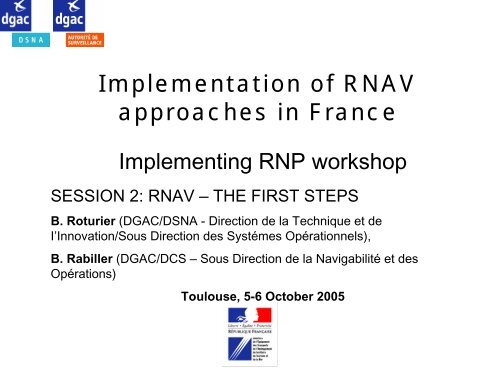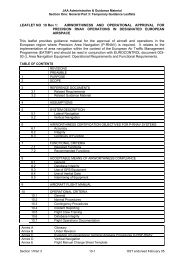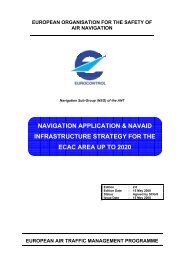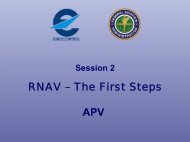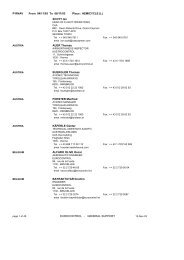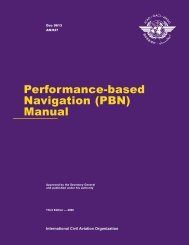GNSS Precision Approaches
GNSS Precision Approaches
GNSS Precision Approaches
Create successful ePaper yourself
Turn your PDF publications into a flip-book with our unique Google optimized e-Paper software.
Ajouter<br />
sigle<br />
DCS<br />
Implementation of RNAV<br />
approaches in France<br />
Implementing RNP workshop<br />
SESSION 2: RNAV – THE FIRST STEPS<br />
B. Roturier (DGAC/DSNA - Direction de la Technique et de<br />
I’Innovation/Sous Direction des Systémes Opérationnels),<br />
B. Rabiller (DGAC/DCS – Sous Direction de la Navigabilité et des<br />
Opérations)<br />
Toulouse, 5-6 October 2005
• RNAV <strong>Approaches</strong> context<br />
Items<br />
• <strong>GNSS</strong> Non <strong>Precision</strong> <strong>Approaches</strong> (NPA)<br />
• <strong>GNSS</strong> <strong>Approaches</strong> with Vertical guidance (APV)<br />
• <strong>GNSS</strong> <strong>Precision</strong> <strong>Approaches</strong> (Cat I)<br />
• Synthesis<br />
-2-
RNAV <strong>Approaches</strong> context<br />
RNP and RNAV approaches<br />
• The RNP concept for approach and landing operations, its<br />
relation with RNAV and the requirements for operational<br />
implementation are currently not fully defined and harmonized<br />
worldwide.<br />
• The ICAO study group RNPSORSG is currently progressing on<br />
this item:<br />
– The updated RNP concept for approaches should accommodate all<br />
performance based operations, including those supported by linear and<br />
angular guidance.<br />
• Approach and landing operations supported by <strong>GNSS</strong> are<br />
performance based operations,<br />
– (see next slide)<br />
-3-
RNAV <strong>Approaches</strong> context<br />
<strong>GNSS</strong> performance requirements<br />
ICAO <strong>GNSS</strong> signal performance requirements<br />
NPA<br />
NPA BaroVNAV<br />
APV I and APV Baro-VNAV<br />
APV II Cat I<br />
50 m (5σ)<br />
20 m (5σ) 10 m(5σ)<br />
40 m 556 m (5σ)<br />
Not to scale!<br />
?? m<br />
?? σ<br />
-4-
RNAV <strong>Approaches</strong> context<br />
French activities<br />
• Since several years, a steering committee supporting the<br />
implementation of RNAV in final approach in French airspace<br />
has assessed the benefits/limitations of different technologies<br />
for RNAV performance based operations:<br />
• Performance based RNAV operations:<br />
– NPA with <strong>GNSS</strong><br />
– NPA with <strong>GNSS</strong> and BaroVNAV continuous descent<br />
– APV BaroVNAV<br />
– APV I&II with <strong>GNSS</strong><br />
– Cat I with <strong>GNSS</strong><br />
• Technologies:<br />
– <strong>GNSS</strong> ABAS (stand alone & multisensors), SBAS, GBAS, BaroVNAV,…<br />
-5-
RNAV <strong>Approaches</strong> context<br />
French activities<br />
• The steering committee is supported by DGAC experts from<br />
different directorate:<br />
– procedure design, infrastructure, aeronautical information services, aircraft<br />
certification & operations, regulation, flight inspection, etc…<br />
• The SC work has led DSNA to recommend a strategy for RNAV<br />
deployment within French airspace. The French regulator,<br />
DAST, will endorse it shortly.<br />
• The main findings of the steering committee and the associated<br />
implementation programme concerning RNAV in final approach<br />
is summarized here.<br />
-6-
• RNAV <strong>GNSS</strong> <strong>Approaches</strong> context<br />
Items<br />
• <strong>GNSS</strong> Non <strong>Precision</strong> <strong>Approaches</strong> (NPA)<br />
• <strong>GNSS</strong> <strong>Approaches</strong> with Vertical guidance (APV)<br />
• <strong>GNSS</strong> <strong>Precision</strong> <strong>Approaches</strong> (Cat I)<br />
• Synthesis<br />
-7-
• Benefits assessment<br />
– Straight approaches for all runway ends<br />
• Safety benefits<br />
RNAV NPA <strong>GNSS</strong><br />
benefits vs. limitations<br />
– Lower lateral dispersion than conventional navaids NPA<br />
• Thanks to <strong>GNSS</strong> improved precision<br />
• Limitations assessment<br />
– Lack of vertical guidance has negative impacts on safety<br />
• Accident and major incidents have occurred these last years in<br />
France on NPA with conventional Navaids.<br />
– Absence of vertical guidance was judged an important factor.<br />
• BaroVNAV may improve safety as an advisory system to fly<br />
Constant Descent Final Approach to, but most BaroVNAV<br />
systems (AC 20-129) do not require integrity<br />
– Altimetry issues (similar to non RNAV NPA)<br />
– Database integrity issues<br />
Other Causes<br />
80%<br />
CFIT statistics<br />
1988-97<br />
(source Honeywell)<br />
-8-<br />
Altimetry Error<br />
Suspected<br />
20%
RNAV NPA <strong>GNSS</strong><br />
implementation<br />
• Conclusion was that there are potential safety benefits in<br />
implementing NPA RNAV based on <strong>GNSS</strong> to allow simpler,<br />
repeatable approach trajectories for all airspace users.<br />
• RNAV <strong>Approaches</strong> steering committee activities:<br />
– Reviews of the requests and the prioritisation of procedure publication<br />
– Coordination with users<br />
– 40 procedures are planned to be published in the next 3 years<br />
• The advisory use of vertical guidance with BaroVNAV on NPA is<br />
accepted:<br />
• Some remaining issues have to clarified (e.g. use of DA vs. MDA), but not identified<br />
today as a blocking point.<br />
⇒Implementation of <strong>GNSS</strong> NPA, with BaroVNAV vertical guidance<br />
as an option, is the first step of the DSNA strategy for RNAV<br />
approaches.<br />
⇒The identified limitations are to be solved within the 2 nd step<br />
-9-
RNAV NPA <strong>GNSS</strong><br />
Typical Approach Chart<br />
-10-
• RNAV <strong>GNSS</strong> <strong>Approaches</strong> context<br />
Items<br />
• <strong>GNSS</strong> Non <strong>Precision</strong> <strong>Approaches</strong> (NPA)<br />
• <strong>GNSS</strong> <strong>Approaches</strong> with Vertical guidance (APV)<br />
• <strong>GNSS</strong> <strong>Precision</strong> <strong>Approaches</strong> (Cat I)<br />
• Synthesis<br />
-11-
RNAV APproaches with<br />
Vertical guidance (APV)<br />
• ICAO recommends large scale deployment of APV:<br />
– 11th Air Navigation Conference (2003)<br />
• Recommends APV I implementation worldwide<br />
– Annex 10 strategy for approach & landing (2005)<br />
• Two technologies are available for vertical guidance on APV:<br />
– BaroVNAV ( operations known as APV baroVNAV)<br />
• Most systems flying today have been certified under AC 20-129 (1988)<br />
– <strong>GNSS</strong> vertical guidance (operations known as LPV, supported by<br />
APV I&II performance requirement)<br />
• SBAS (WAAS (US/Canada/Mexico), EGNOS (Europe), etc..),<br />
• GBAS/GRAS (Australia)<br />
• Galileo (worldwide - in the future)<br />
-12-
APV BaroVNAV<br />
vs. NPA BaroVNAV<br />
MDA or DA<br />
• APV BaroVNAV aims at lower operational minima with reduced<br />
obstacle separation wrt NPA BaroVNAV<br />
• BaroVNAV has to be used as a primary navigation system in APV,<br />
whereas advisory use only is required in NPA<br />
⇒APV baroVNAV requires a specific safety assessment<br />
DA<br />
-13-
• Benefits assessment<br />
APV BaroVNAV<br />
benefits vs. limitations<br />
– BaroVNAV exists on a large number of aircrafts (~80% of Paris CDG aircraft)<br />
• Limitations assessment<br />
– Most equipped aircrafts are certified for an advisory use only (AC 20-129)<br />
• The aircraft certification requirements to implement the new ICAO PANS OPS APV<br />
BaroVNAV criteria are unknown<br />
– Discussed recently within JAA, under AMC – 20XX elaboration<br />
– BaroVNAV Integrity issues<br />
• Increased issues wrt NPA BaroVNAV due to obstacle clearance reduction:<br />
– Wrong altimeter setting, wrong or outdated QNH transmitted by ATC …<br />
• DSNA assessment is that APV BaroVNAV integrity issues require appropriate<br />
mitigation technique:<br />
– But still unidentified at this stage<br />
⇒ Due to aircraft certification open issues and lack of identified<br />
integrity mitigation techniques, DGAC has decided not to authorize<br />
APV BaroVNAV publication<br />
-14-
APV I&II<br />
benefits vs. limitations<br />
• Benefits assessment<br />
– Identification of runway ends where an operational benefit for APV I&II<br />
is expected:<br />
• Main airports (ex. Paris CDG), Middle sized airports (ex. Lille), Small airports<br />
(ex. Dinard), Sites with environmental constraints (ex. Nice), Helicopters,…<br />
– APV I (with EGNOS in this study) improves the approach operational<br />
context, and allow to reduce minima (250 ft – obstacles permitting)<br />
• Similar results were obtained in the USA (APV I WAAS) and in<br />
Australia(APV I GRAS), expected to be valid also with future Galileo APV I&II<br />
– Database integrity issue is solved<br />
• Final Approach Segment data block protected by a Cyclic Redundant Code<br />
– ILS look alike operational concept and integrity (xLS) – minima 250 ft<br />
– All users may have access to the technology<br />
• Limitations assessment<br />
– <strong>Approaches</strong> supported by APV I&II is a new performance based<br />
operation<br />
• Requires an airborne upgrade, issues with users equipment rate<br />
• Requires a qualified <strong>GNSS</strong> system – expected 2007 for EGNOS<br />
-15-
APV I&II<br />
implementation<br />
• Conclusion is that APV I &II performance based operations allow<br />
to fulfil most safety & performance requirements for RNAV for<br />
approaches.<br />
• Current DGAC implementation strategy is:<br />
– to break the user equipment chicken and egg loop by upgrading RNAV<br />
<strong>GNSS</strong> NPA procedures to APV I supported by EGNOS – the first system to<br />
support APV I&II performance level in Europe.<br />
– develop partnership with aircraft/helicopter manufacturers and operators<br />
• Galileo should also support APV I&II in the future<br />
– but when will an aviation qualified Galileo be available: 2012?… 2015?…<br />
⇒ An EGNOS APV I implementation WG has been set up by DSNA<br />
in 2004. Target is:<br />
– first procedure publication in 2007,<br />
– all <strong>GNSS</strong> NPA procedures upgraded to APV I<br />
-16-
Typical RNAV future approach<br />
chart<br />
LPV: minima APV I&II SBAS<br />
(EGNOS, WAAS,…)<br />
-17-<br />
LNAV/VNAV: minima APV BaroVNAV (if<br />
supported!)<br />
LNAV: minima <strong>GNSS</strong> NPA
• RNAV <strong>GNSS</strong> <strong>Approaches</strong> context<br />
Items<br />
• <strong>GNSS</strong> Non <strong>Precision</strong> <strong>Approaches</strong> (NPA)<br />
• <strong>GNSS</strong> <strong>Approaches</strong> with Vertical guidance (APV)<br />
• <strong>GNSS</strong> <strong>Precision</strong> <strong>Approaches</strong> (Cat I)<br />
• Synthesis<br />
-18-
<strong>GNSS</strong> <strong>Precision</strong> <strong>Approaches</strong><br />
GBAS Category I<br />
• The business case for GBAS Cat I, which was very promising 10<br />
years ago, is now limited since :<br />
– There is still a high density of conventional navaids (ILS in particular)<br />
– SBAS brings close operational performance with APV I&II performance<br />
levels<br />
– The evolution of GBAS CAT I toward CATII/III is not yet clearly defined<br />
– The FAA deployment program initially planned for 2006 has been delayed.<br />
• DSNA activities for GBAS Cat I:<br />
– support Airbus certification,<br />
– prepare possibly a few stations installations (TBC), in overseas territories<br />
– support Cat II/III standardisation<br />
-19-
<strong>GNSS</strong> <strong>Precision</strong><br />
<strong>Approaches</strong><br />
GBAS Category I<br />
-20-
• RNAV <strong>GNSS</strong> <strong>Approaches</strong> context<br />
Items<br />
• <strong>GNSS</strong> Non <strong>Precision</strong> <strong>Approaches</strong> (NPA)<br />
• <strong>GNSS</strong> <strong>Approaches</strong> with Vertical guidance (APV)<br />
• <strong>GNSS</strong> <strong>Precision</strong> <strong>Approaches</strong> (Cat I)<br />
• Synthesis<br />
-21-
Synthesis<br />
• Since 2000 DSNA has assessed different performance based<br />
operations to support RNAV for approach & landing operations.<br />
• In 2005 DSNA has proposed the following strategy for RNAV<br />
approaches implementation:<br />
– RNAV with <strong>GNSS</strong> NPA as a first step,<br />
• BaroVNAV may be used as an advisory system to improve safety<br />
– RNAV with <strong>GNSS</strong> APV I as a second step,<br />
• In line with ICAO strategy, <strong>GNSS</strong> geometric vertical guidance will allow to<br />
improve safety and airport accessibility wrt NPA.<br />
• EGNOS is the first system in Europe to support APV I performance<br />
– Requires a qualified EGNOS system & EGNOS operator (expected 2007)<br />
– The users equipment rate toward EGNOS/WAAS receivers is a major issue<br />
– No APV BaroVNAV implementation currently planned,<br />
– GBAS CAT I ground stations might be deployed on some overseas,<br />
airports (TBC)<br />
• Cat I implementation allows to support Cat II/III standardisation<br />
-22-
Backup Slides<br />
-23-
RNAV <strong>GNSS</strong> <strong>Approaches</strong><br />
context<br />
ICAO <strong>GNSS</strong> augmentations<br />
Geostationary Satellite<br />
Based Augmentation System<br />
(SBAS)<br />
GALILEO<br />
(TBD)<br />
Ground Based<br />
Augmentation System<br />
(GBAS)<br />
<strong>GNSS</strong><br />
GPS<br />
GLONASS<br />
Aircraft Based<br />
Augmentation System<br />
(ABAS)<br />
-24-
RNAV <strong>GNSS</strong> <strong>Approaches</strong><br />
context<br />
ICAO Classification<br />
• ICAO <strong>Approaches</strong> definition:<br />
– Non <strong>Precision</strong> Approach (NPA)<br />
• Lateral Guidance Only<br />
– But Barometric Vertical guidance (FMS) may be used as an advisory system to fly CDFA<br />
– APproach with Vertical guidance (APV)<br />
• Lateral and Vertical Guidance<br />
• Two basic technologies can be used:<br />
– Barometric vertical guidance, with NPA like <strong>GNSS</strong> lateral guidance<br />
(APV/Baro-VNAV)<br />
– <strong>GNSS</strong> vertical guidance, with two performance levels, including improved Localizer like<br />
performance for lateral guidance<br />
(APV-I, APV-II)<br />
– <strong>Precision</strong> Approach (PA)<br />
• Lateral and Vertical Guidance<br />
• Three performance levels (Cat I, Cat II, Cat III)<br />
-25-
NPA<br />
Non <strong>Precision</strong> <strong>Approaches</strong><br />
Conventional<br />
Navaids<br />
VOR/DME<br />
NDB<br />
Localizer<br />
...<br />
RNAV <strong>GNSS</strong> <strong>Approaches</strong><br />
context<br />
RNAV<br />
<strong>GNSS</strong> ABAS<br />
DME/DME<br />
APV BaroVNAV<br />
<strong>GNSS</strong> ABAS<br />
DME/DME<br />
+<br />
BaroVNAV vertical<br />
ICAO Classification<br />
ICAO<br />
Classification<br />
APV<br />
APproaches with Vertical guidance<br />
RNAV<br />
APV I&II<br />
<strong>GNSS</strong> SBAS<br />
<strong>GNSS</strong> GBAS<br />
<strong>GNSS</strong> Galileo<br />
...<br />
Conventional<br />
Navaids<br />
ILS<br />
MLS<br />
PAR<br />
PA<br />
<strong>Precision</strong> <strong>Approaches</strong><br />
RNAV<br />
<strong>GNSS</strong> GBAS<br />
...<br />
-26-
Statistical distribution of<br />
minima based on a US study<br />
• Minima (HAT) results for LPV(SBAS APV I), LNAV-VNAV (APV Baro-VNAV) and<br />
RNP approaches at 1534 US airports<br />
-27-
The APV implementation study in<br />
France - Status of work in Dec 2003<br />
Airport QFU APV 1<br />
operationa<br />
l gain<br />
Paris le<br />
Bourget<br />
07 ILS<br />
Backup<br />
Paris CDG 26 L ILS Backup<br />
Keeping<br />
parallel<br />
runway<br />
capability<br />
Nice 04R environmen<br />
tal<br />
Montpellier 13L Air France<br />
List<br />
Approach<br />
procedure<br />
Glide<br />
Slope<br />
Angle<br />
OCH<br />
Cat D<br />
Gain OCH<br />
APV 1<br />
APV1 3° 325 Ft 105 ft<br />
ILS DME 3° 370 ft /<br />
VORDME 3° 430 ft /<br />
APV1 3° 325 ft min 22 ft min<br />
242 ft max 105 ft max<br />
ILS DME 3° 198 ft /<br />
LLZ DME 3° 347 ft /<br />
APV1 3° 279 ft 21 ft<br />
ILS DME 3° 270 ft /<br />
LLZ DME 3° 300 ft /<br />
APV1 3° 289 ft 158 ft<br />
APV1 3.5° 289 ft 158 ft<br />
VORDME 6.4 %<br />
3.66°<br />
447 ft /<br />
-28-
The APV implementation study<br />
in France - Status of work in Dec 2003<br />
Airport QFU APV 1<br />
operationa<br />
l gain<br />
Approach<br />
procedure<br />
Glide<br />
Slope<br />
Angle<br />
OCH Gain OCH<br />
APV 1<br />
Beauvais 13 Low cost APV1 3° 258 ft 102 ft<br />
Roanne 20 High slope<br />
reduction<br />
Lille 08 Air France<br />
list<br />
Nantes 21 Air France<br />
list<br />
L VOR 3° 360 ft /<br />
APV1 3° 250 ft 0 ft (2)<br />
VOR 6.3 % 3.6° 504 ft /<br />
APV1 3° 271 ft 167 or 54 ft<br />
VOR 438 ft /<br />
VORDME 5.7% 323 ft /<br />
APV1 3° 276 Ft 81 ft<br />
VOPRDME 3° 357 ft /<br />
Pau 13 APV1 3° 220 ft 630 ft<br />
Biarritz 09 Air France<br />
list<br />
MVI 850 ft /<br />
APV1 3° 248 ft 133 ft<br />
VORDME 3° 381 ft /<br />
-29-
Aérodrome QFU APV 1<br />
operation<br />
al gain<br />
Fort de<br />
France<br />
The APV implementation study<br />
in France - Status of work in Dec 2003<br />
27 Reduce<br />
slope and<br />
minima<br />
Albi 27 Allow<br />
straight in<br />
approach<br />
Mende 13 High slope<br />
reduction<br />
Dinard 17 High slope<br />
reduction<br />
St Denis 30 High slope<br />
reduction<br />
Approach<br />
procedure<br />
APV1 Rwy<br />
27<br />
APV1 Rwy<br />
27<br />
VORDME<br />
Rwy 27<br />
Glide<br />
Slope<br />
Angle<br />
OCH Gain OCH<br />
APV 1<br />
3° 901 ft 349 ft<br />
3.5° 901 ft 349 ft<br />
3.5° 6.1% 1250 ft /<br />
APV1 rwy 27 3° Cat C<br />
MVI following 3.2°<br />
398 ft<br />
Cat C<br />
ILS<br />
890 ft<br />
APV1 Rwy<br />
13<br />
VOR<br />
/LLZ/DME<br />
3.5 ° Cat B<br />
4°<br />
369 ft<br />
Cat B<br />
530 ft<br />
492 ft<br />
/<br />
161 ft<br />
APV1 3° 223ft 105 ft<br />
VOR/DME 4° 328 ft /<br />
APV1 3.5° 294 ft 435 ft<br />
VOR/DME 3.7° 729 ft /<br />
/<br />
-30-
Session 2<br />
RNAV – The First Steps<br />
Applications<br />
-31-


